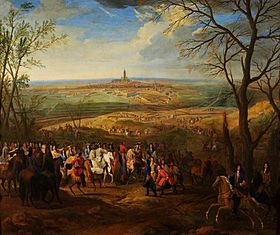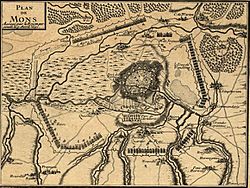Siege of Mons (1691) facts for kids
Quick facts for kids Siege of Mons (1691) |
|||||||
|---|---|---|---|---|---|---|---|
| Part of the Nine Years' War | |||||||
 King Louis XIV accepting the surrender of Mons |
|||||||
|
|||||||
| Belligerents | |||||||
| Commanders and leaders | |||||||
| King Louis XIV Marquis de Vauban Duc de Boufflers Louis, Grand Dauphin |
|||||||
| Strength | |||||||
| 92,000 90 guns |
~4,800 | ||||||
| Casualties and losses | |||||||
| No data | No data | ||||||
The Siege of Mons was a major battle during the Nine Years' War, fought from March 15 to April 10, 1691. This battle was the main goal for France in 1691 in the Spanish Netherlands. The city of Mons was surrounded and captured quickly, with very few losses for the French.
During this war, both the French army, led by King Louis XIV, and the Grand Alliance forces, led by King William III, often fought sieges. A siege is when an army surrounds a city or fort to cut off supplies and force it to surrender. After Mons, the French army continued to fight. However, the overall situation in the war didn't change much. Both sides went back to their winter camps when the fighting season ended.
What Led to the Siege?
In 1690, French forces had some big wins. A French general named Luxembourg won a key battle at Fleurus. This stopped the Grand Alliance from invading France. At sea, the French navy also defeated English and Dutch ships. In Italy, another French general, Catinat, won a battle, but his army was too small to make a big difference. The only good news for the Grand Alliance in 1690 was King William's victory in Ireland. Even with these wins, France couldn't break the group of countries fighting against King Louis XIV.
For 1691, France planned two main attacks. One was on Nice in Italy, and the other was on Mons in the Spanish Netherlands. The Netherlands was where France put most of its effort. King Louis's war minister, Louvois, worked hard to build an even bigger army there. These attacks were planned for very early in the year. This was a smart move, as it meant they could attack before the enemy was fully ready.
Meanwhile, King William felt secure enough in Ireland to return to Europe. He arrived in The Hague in February to get his army ready. He gathered a huge force of 220,000 soldiers. In mid-March, he received news that Mons was under siege.
The Siege of Mons Begins
Louvois, the French war minister, spent the whole winter getting ready for the siege of Mons. Supplies were stored in nearby cities like Namur and Philippeville. A massive 21,000 workers were hired to build walls around Mons. These walls were called "lines of circumvallation." They were built to keep anyone inside Mons from escaping and to stop any enemy armies from reaching the city.
King Louis XIV himself came to the Spanish Netherlands to lead his army. He arrived on March 21. His army had 46,000 soldiers and was led by his brilliant engineer, Vauban. They surrounded Mons, which had about 4,800 defenders inside. The Grand Alliance had an army of 38,000 soldiers under King William. Their goal was to help Mons. However, another French army, also 46,000 strong, blocked them. This made it impossible for the Grand Alliance to stop the siege.
The siege officially began on March 15. The French started digging trenches closer to the city ten days later. This was one of the most intense attacks in King Louis's wars. Two groups of cannons, each with 12 large mortars, fired constantly at the city. By March 30, the French had fired 7,000 cannonballs and 3,000 mortar shells.
Finally, at 5:00 PM on April 8, the people defending Mons signaled that they wanted to surrender. The terms were agreed upon. Two days later, the remaining defenders marched out of the city.
What Happened After the Siege?
The siege of Mons finished before the usual fighting season even began. King Louis returned to his palace at Versailles on April 12. King William sent his troops to different forts and then went back to The Hague.
France then got ready for the rest of the 1691 fighting season. They created five large armies to fight on five different fronts. The biggest army, with 49 battalions and 140 squadrons, was in Flanders. However, not much else happened after the siege for either side. The French general Luxembourg destroyed the town of Halle in May. Another general, Boufflers, attacked the neutral city of Liège in June. But these attacks didn't lead to any major political changes.
Some of King Louis's advisors thought these wins should be followed by a big battle to end the war. Others suggested attacking Brussels. But these ideas were not followed.
Meanwhile, King William arrived in Anderlecht in June to lead the Allied army. This army had 63 battalions and 180 squadrons, totaling 56,000 men. Luxembourg managed to stop William from attacking another French city. After William left his troops with another general, Luxembourg's cavalry defeated part of the Allied army in September. After this, both sides went back to their winter camps.


